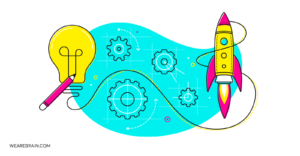Continuous product development: Build to last

Today, products need to do more than just survive launch day; they need to evolve continuously to stay competitive and relevant. It’s about making products better, faster, smarter—and keeping them aligned with both customer expectations and industry trends.
Continuous product development (CPD), or continuous product design, is the antidote to this problem. By embracing a constant cycle of analysis, adjustment, and improvement, businesses ensure their products adapt to users’ evolving needs.
Let’s explore the why, the how, and the critical elements of a CPD process that can lead to long-term success.
What is continuous product development?
Continuous product development is an approach where companies keep refining and improving their products after launch. It’s less about being first to market and more about being the one that remains valuable over time.
In a sense, the product is never “finished”; rather, it is a work in progress, adapting to feedback, data, and market trends. Think of it like a chef tweaking a signature dish based on customer feedback—adding a pinch more salt, using seasonal ingredients, or changing the presentation.
For a product to remain successful, it must stay relevant. Continuous development (CD) and continuous improvement (CI) encourage responsiveness, adaptability, and competitiveness—qualities that foster long-term success in any market.
The importance of continuous improvement
Most companies revel in the excitement of launching a new product. But if they stop there, they risk becoming obsolete. Continuous improvement (CI) is the idea that products are always in a state of refinement. CI is a never-ending loop of seeking and implementing small improvements, resulting in a product that remains relevant and valuable to users.
A significant part of CI involves enhancing user satisfaction. After all, a product that fails to meet changing user expectations will quickly lose its appeal. Likewise, market competitiveness is sustained when a product doesn’t stagnate but grows in line with both user needs and competitor offerings.
Continuous improvement isn’t just about keeping up with the times; it’s about creating a product that can adapt to—and even predict—future user requirements.
The role of data in continuous development
Imagine if every decision you made about a product was backed by data showing exactly what users liked, disliked, or needed. In CPD, data-driven decision-making is the compass guiding development efforts. By analysing usage patterns, user feedback, and behavioural data, companies gain insight into what aspects of the product need refining.
For instance, tracking how users interact with features can reveal which aspects delight them and which frustrate them. This allows for informed decisions that reduce the risks involved with product updates. If feedback shows that customers are ignoring a certain feature, developers know where to focus next. It’s like having a treasure map with a giant “X” marked where your product’s improvement opportunities lie.
Agile methodology: The key to continuous improvement
The term Agile is tossed around a lot in tech circles, but when it comes to continuous product development, it’s the perfect sidekick. The Agile method breaks down product development into short cycles or “sprints,” enabling rapid, incremental changes. Rather than waiting for a grand, all-encompassing update, Agile allows for quick wins and frequent improvements.
Short development cycles let teams experiment, test, and refine more effectively. This iterative approach means that feedback gathered after one update can be applied to the next cycle, creating a responsive, adaptable product evolution.
Agile and CPD go hand-in-hand, like Batman and Robin—together, they’re unstoppable at keeping products current and aligned with user needs.
User feedback loops: Your secret weapon
Direct feedback from users is a treasure trove of insights that can inform product updates and feature enhancements. Feedback loops are an ongoing conversation with the user base, offering insights into pain points, desires, and expectations. By building systems that gather feedback—like surveys, in-app prompts, or user interviews—companies can continuously learn from real-world product interactions.
User feedback is like having a GPS for product direction. It shows developers where they’ve gone astray or where they’re hitting the mark. It also makes users feel like co-creators, reinforcing their loyalty and increasing product stickiness. When feedback is a regular part of the CPD process, updates reflect real needs, ensuring the product stays relevant.
Releasing iterative updates
For most users, a product that’s updated frequently with minor improvements is more appealing than one that’s left to gather dust until a major overhaul. Iterative updates are about releasing small, regular updates rather than waiting for a massive, infrequent release. These smaller releases allow products to adapt quickly to feedback and market changes, keeping them fresh and functional.
Imagine a favourite app on your phone; if it went years without an update, you’d likely lose interest or move on to a competitor that feels more responsive. By focusing on small updates, companies can improve the product incrementally, strengthening user loyalty and ensuring the product remains competitive.
Think of iterative updates as giving your product a series of quick, regular tune-ups rather than a complete engine replacement every few years.
Continuous testing and monitoring: Your safety net
No update is complete without rigorous testing and monitoring. This is where developers can catch bugs, ensure quality, and make refinements based on real-world use. A/B testing is a common tool in this stage, allowing teams to trial different versions of a feature and choose the best-performing one. It’s like test-driving a car model before it hits the showroom.
Continuous monitoring, especially performance monitoring, helps teams keep an eye on how well the product is performing in real-time. It’s like having a dashboard that shows where your product’s weak spots are. By identifying issues early, companies can fix problems before they escalate, ensuring a seamless user experience.
Aligning product development with market trends
A product can only be as good as its relevance to the market. Staying ahead of competitors involves an active effort to track market trends and user expectations. In CPD, this means using market research to predict where customer needs are headed and aligning product development accordingly.
Market alignment ensures that products don’t just follow trends; they help shape them. This proactive approach requires regular research, competitor analysis, and interaction with users. Think of it as a game of chess—anticipating the next move helps to stay a few steps ahead, ensuring long-term product success.
Build a product users will love – forever
Continuous product development is the secret to building products that don’t just survive but thrive. It’s about embracing change, innovation, and adaptability as core components of product strategy. From using data to guide decisions and gathering user feedback to following Agile principles and releasing frequent updates, CPD involves a set of practices that turn development into a journey rather than a destination.
Need help developing a product users will love?
WeAreBrain is an award-winning, full-service boutique agency specialising in business-critical platforms. Our 10x approach spans three dynamic stages of expertise: Idea to Plan, Plan to Product, and Grow 10x. Dive into one, mix and match, or take advantage of the full journey—whatever fits your goals best. Our expert team works in sync across these stages, providing you with focused, high-impact support wherever you are in your journey.
Get in touch to arrange a brainstorming session.
Dmitry Ermakov
Working Machines
An executive’s guide to AI and Intelligent Automation. Working Machines takes a look at how the renewed vigour for the development of Artificial Intelligence and Intelligent Automation technology has begun to change how businesses operate.







